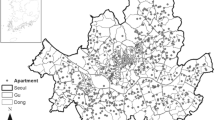Abstract
Due to the rapid economic growth and urbanization, China’s real estate industry has been undergoing a fast-paced development in recent decades. However, the spatial imbalance between the economic growth in urban and that in rural areas and the excessive growth and fluctuations of house prices in both areas had quickly caught public’s attention. Not surprisingly, these issues had become a focus of urban and regional economic research. Efficient and accurate prediction of housing prices remains a much needed but disputable topic. Currently, based on the trends and changes in the financial market, population migration and urbanization processes, numerous case studies have been developed to evaluate the mechanism of real estate’s price fluctuations. However, few studies were conducted to examine the space-time dynamics of how housing prices fluctuated from a big data perspective. Using data from China’s leading online real estate platform {sofang.com}, we investigated the spatiotemporal trends of the fluctuations of housing prices in the context of big data. This paper uses spatial data analytics and modeling techniques to: first, identify the spatial distribution of housing prices at micro level; second, explore the space-time dynamics of residential properties in the market; and third, detect if there exist geographic disparity in terms of housing prices. Results from our analysis revealed the space-time patterns of the housing prices in a large metropolitan area, demonstrating the utility of big data and means of analyzing big data.








Similar content being viewed by others
References
Barros, C. P., Chen, Z., & Gil-Alana, L. A. (2013). Long memory in the housing price indices in China. Asian Journal of Empirical Research, 3(7), 785–807.
Brunsdon, C., Fotheringham, S., & Charlton, M. (1998). Geographically weighted regression. Journal of the Royal Statistical Society: Series D (The Statistician), 47(3), 431–443.
Cahill, M., & Mulligan, G. (2007). Using geographically weighted regression to explore local crime patterns. Social Science Computer Review, 25(2), 174–193.
Chen, J., Guo, F., & Wu, Y. (2011). One decade of urban housing reform in China: urban housing price dynamics and the role of migration and urbanization, 1995–2005. Habitat International, 35(1), 1–8.
Chu, H., Huang, B., & Lin, C. (2015). Modeling the spatio-temporal heterogeneity in the p M10–PM2. 5 relationship. Atmospheric Environment, 102, 176–182.
Deng, Y., Gyourko, J. & Wu, J. (2012), Land and house price measurement in China, Report, NBER Working Paper No. 18403. National Bureau of Economic Research.
Hu, X., Hong, W., Qiu, R., Hong, T., Chen, C., & Wu, C. (2015). Geographic variations of ecosystem service intensity in Fuzhou City, China. Science of The Total Environment, 512, 215–226.
Huang, H., & Yin, L. (2014). Creating sustainable urban built environments: an application of hedonic house price models in Wuhan, China. Journal of Housing and the Built Environment, 30(2), 1–17.
Jiang, B. (2013). Head/tail breaks: a new classification scheme for data with a heavy-tailed distribution. The Professional Geographer, 65(3), 482–494.
Jiang, B., & Miao, Y. (2014). The evolution of natural cities from the perspective of location-based social media. The Professional Geographer, 67(2), 1–12.
Jim, C. Y., & Chen, W. Y. (2006). Impacts of urban environmental elements on residential housing prices in Guangzhou (China). Landscape and Urban Planning, 78(4), 422–434.
Kong, F., Yin, H., & Nakagoshi, N. (2007). Using GIS and landscape metrics in the hedonic price modeling of the amenity value of urban green space: a case study in Jinan City, China. Landscape and Urban Planning, 79(3–4), 240–252.
Lee, J., & Wong, D. W. S. (2001). Statistical analysis with ArcView GIS. New York: Wiley.
Lee, J., Lay, J., Chin, W. C. B., Chi, Y., & Hsueh, Y. (2014). An experiment to model spatial diffusion process with nearest neighbor analysis and regression estimation. International Journal of Applied Geospatial Research, 5(1), 1–15.
Lu, B., Charlton, M., Harris, P., & Fotheringham, A. S. (2014). Geographically weighted regression with a non-Euclidean distance metric: a case study using hedonic house price data. International Journal of Geographical Information Science, 28(4), 660–681.
Newswire, P. (2015). SouFun announces five-year plan with a new flagship Website Fang.com.
Rapoza, K. (2011). China’s Weibos vs US’s Twitter: And the Winner Is? Forbes. Retrieved 25 August 2015.
Rosenblatt, M. (1956). Remarks on some nonparametric estimates of a density function. The Annals of Mathematical Statistics, 27(3), 832–837.
Rossbacher, L. A. (1986). Nearest-neighbour analysis: a technique for quantitative evaluation of polygonal ground patterns. Geografiska Annaler. Series A. Physical Geography, 68(1), 101–105.
Wang, P., & Kang, M. (2014). An empirical analysis on the housing prices in the Pearl River Delta Economic Region of China. International Journal of Urban Sciences, 18(1), 103–114.
Wheeler, D., & Tiefelsdorf, M. (2005). Multicollinearity and correlation among local regression coefficients in geographically weighted regression. Journal of Geographical Systems, 7(2), 161–187.
Wu, J., Gyourko, J., & Deng, Y. (2012). Evaluating conditions in major Chinese housing markets. Regional Science and Urban Economics, 42(3), 531–543.
Wu, J., Deng, Y., & Liu, H. (2014). House price index construction in the nascent housing market: the case of china. The Journal of Real Estate Finance and Economics, 48(3), 522–545.
Xu, X. E., & Chen, T. (2012). The effect of monetary policy on real estate price growth in China. Pacific-Basin Finance Journal, 20(1), 62–77.
Ye, X., & Rey, S. (2013). A framework for exploratory space-time analysis of economic data. The Annals of Regional Science, 50(1), 315–339.
Acknowledgments
This work has been supported by the National Science Foundation (1416509, 1535031, 1535081) and the National Natural Science Foundation of China (41301426).
Author information
Authors and Affiliations
Corresponding author
Rights and permissions
About this article
Cite this article
Li, S., Ye, X., Lee, J. et al. Spatiotemporal Analysis of Housing Prices in China: A Big Data Perspective. Appl. Spatial Analysis 10, 421–433 (2017). https://doi.org/10.1007/s12061-016-9185-3
Received:
Accepted:
Published:
Issue Date:
DOI: https://doi.org/10.1007/s12061-016-9185-3




